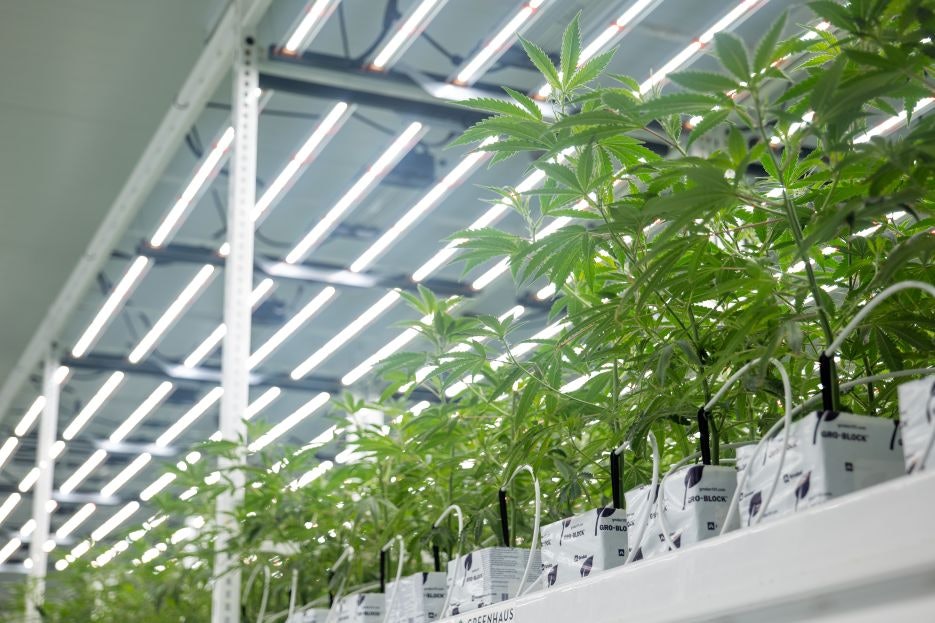If you’re in the market for a lighting retrofit, return on investment (ROI) is probably a top priority. But calculating an LED retrofit’s ROI isn’t as simple as looking at the price of new fixtures. Done properly, a lighting retrofit impacts multiple aspects of your cultivation operation, all of which impact ROI on the lighting solutions you buy.
For a deeper dive into what to consider when calculating ROI for cannabis lighting upgrades, Cannabis Business Times turned to Taylor Kirk, Fluence’s horticulture service specialist. Kirk has helped scores of growers upgrade their cultivation lighting and maximize their investment’s returns.
To accurately assess the potential ROI of an LED retrofit—or compare lighting solutions on a new build—Kirk advises a comprehensive approach that considers these five factors:
1. Capital Expenditures (CapEx)
Depending on your existing lighting system, optimizing your grow through a lighting retrofit may involve a 1:1 fixture replacement, like those possible with the Fluence RAPTR, or your plans may call for fixtures that require more preparation and expense than plug-and-play.
Kirk says CapEx considerations for any project should include all expenses needed to make your new assets operational. Along with your fixture costs, this encompasses infrastructure modifications, including necessary changes to your electrical infrastructure. And don’t forget the initial labor expense required if your plans call for outside help for those changes.
It’s also important to remember that retrofits are opportunities to improve or correct limitations in your facility’s original lighting design.
“You may recognize that the initial install was lacking on some component of the light distribution. This is the time to change the lighting arrangements to overcome those uniformity concerns,” Kirk says. Though changes increase CapEx, improved uniformity will benefit your grow long term.
Rebates may lower your CapEx and boost your ROI in return. Kirk suggests there’s no better time to explore rebates than now.
“Energy providers who are incentivizing rebates have a certain amount of money they’re willing to give out,” he says, noting that you never know when programs may change or end. “You want to be one of the first movers and have that advantage.”
2. Operational Expenses (OpEx)
Savings on energy consumption for cultivation lighting is usually the first benefit operators consider when looking at retrofit ROI. In fact, 74% of commercial cultivators growing indoors or in greenhouses cited “energy efficiency” as a top LED benefit, according to the “2024 State of the Cannabis Lighting Market” report. Efficiency gains of 20 percent with an LED retrofit aren’t uncommon, according to Fluence, but monetary savings vary significantly depending on where you grow.
Kirk points out that energy rates in some areas may be as low as seven cents per kilowatt hour, while kilowatt costs may run three times that amount in a city like Los Angeles. But a retrofit’s impact on energy consumption—and ROIs—transcends the cost of running your new lights.
“Then there are the other costs for energy that are also influenced by the lighting, such as the HVAC, air conditioning, heating and dehumidification components,” Kirk explains.
“If the original room you’re working in is under designed for a higher-performing LED application, you may need to increase the amount of dehumidification you have. If you’re adding extra dehumidifiers, that’s an additional CapEx expense and increased operational expense in your electrical use for the new equipment,” he adds. And, of course, both impact ROI.
Even so, efficiency gains in the environmental management of rooms upgraded with LED lighting solutions may mean you still end up lowering operating expenses. Every case is different, Kirk says.
Ongoing labor and maintenance costs associated with new equipment and other changes in the room should be considered when calculating your ROI, too. Lighting that is easy to clean and maintain helps lowers expense and improve returns.
3. Yield Potential
Kirk emphasizes that yield potential is one of the most important factors to consider when looking at ROI on an LED retrofit. But gains only hold true when your new system allows yield potential to be fully realized, and that requires more than just new lights.
“Once we’ve decided the path we’re going to go on, then we can look at making assumptions on increase in yield, which would obviously have an impact on your annual revenue,” Kirk says.
With Fluence, those assumptions are backed by years of research and customer case studies that show increased lighting equates to increased yields. In a wattage-match LED retrofit, yield increases of 30 to 40 percent are common, Kirk says, as long as everything else in the cultivation program is managed properly.
“There’s almost always a direct correlation between additional light received by the plant and increased yield. If you’re increasing the crop’s light received by 40% and you’re providing an optimal environment, you should be seeing roughly 40% increase in yield,” Kirk says, adding that just two harvests with extra yields often pay for a flower room’s new lights.
Though increases in annual yield can significantly accelerate ROI, higher yields come with higher operating costs.
As Kirk points out, a ripple effect happens. Higher-producing plants consume more fertilizer, water and CO2. The key to accurate ROI calculation is viewing those expenses through the framework of added profit from gains in yield.
4. Long-Term Impact
Kirk suggests that an ROI mindset should look beyond how soon you’ll get your return. Once you factor in all your expenses, offset that with increased revenues, and pay yourself back, your retrofit keeps on giving, adding value to your business and opportunities for reinvestment.
“A lot of people are doing a roll out of retrofits that are maybe one room at a time, and then it’s a multiplier effect,” he explains. “Once you pay for that room, and you start reinvesting the extra money you’re making back into your business, then that exponentially starts rolling across the rest of your facility until you’ve completed all the retrofitting.”
Working with the right lighting solutions provider gives you an opportunity to compare different products, between competing companies or within one company’s portfolio. Then you can discover which options will deliver the fastest ROI, greatest long-term benefits and which path is best for you.
Tariffs currently in the news also have implications for ROI now and in the future. Kirk says all lighting companies will be impacted by the current tariff situation, but how each company handles tariffs in terms of price increases or surcharges will differ.
Talking with potential lighting providers about how their company plans to handle tariffs is a conversation you want to have, so you understand the consequences on ROI.
5. Costs of Inefficiency and Delay
As Kirk explains, many people considering a retrofit only look at the cost of the investment and don’t think about the benefits. A few more consider increased annual revenue potential. But there’s still more to consider when calculating your ROI.
“You have the cost, the CapEx implications of all these things. Then you have the time of missing out on the additional revenue that’s going to benefit your business,” he explains.
To get an accurate picture of ROI on your lighting investment, you should consider what you’re losing every day from current inefficiencies and decision-making delays.
“It’s harder now than ever for cannabis companies to survive in this hypercompetitive marketplace,” Kirk says. “You hear about more and more companies shutting down, people exiting the industry altogether or getting bought out. The longer you delay and run an inefficient operation, the faster you’re going to run out of business.”
The final key in calculating potential ROI is to consider your upgrade’s comprehensive financial impact across multiple operational dimensions, including profit-sapping inefficiencies and delays.
“Time is of the essence,” Kirk says. “By reducing your OpEx and increasing your production with an LED retrofit, now you have increased your bottom line. That’s what ROI’s really about in the end.”
Kirk adds that your lighting solutions provider should be able to walk you through these factors and help you determine what’s best for you and your ROI—and still be there for you after the sale.
More from our latest newsletter:
Sponsored: King City Gardens’ Untold Story
Sponsored: The Highest Output SPYDR Ever: SPYDR 2h
Are you overlooking these 5 critical factors in determining when you will see a return on your investment in LED lighting? Read More


